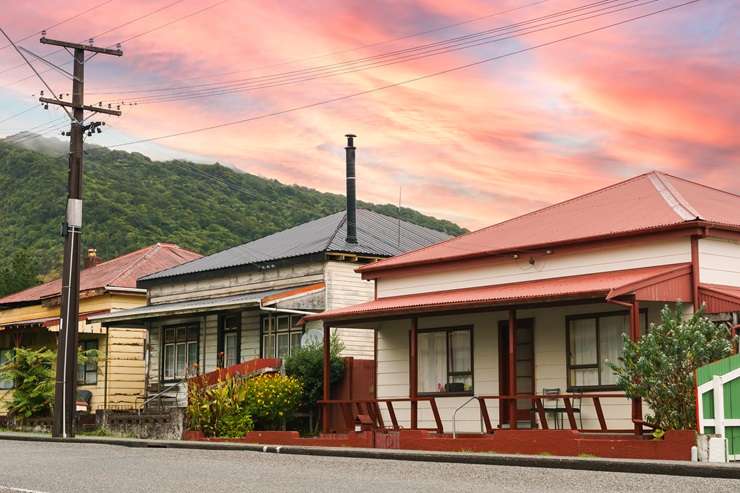Buying a home in New Zealand is $8000 cheaper now than a year ago, but OneRoof's latest monthly house price index shows prices are starting to climb again.
The index also identified a handful of hotspots enjoying more than 10% property value growth this year.
New Zealand’s top growth suburb in 2024 was Blaketown, in the West Coast town of Grey, where the average property value jumped more than 25% in the past 12 months to a still affordable $349,000.
Start your property search
OneRoof editor Owen Vaughan said: "In fact, most of the best-performing suburbs this year have average property values of less than $500,000 - well within the reach of budget-conscious first-home buyers and investors."
Vaughan said the nationwide average property value rose 0.9% ($9000) to $966,000 in the three months ending December - building on the 0.7% rise in the three months ending November.
Eleven regions recorded property value gains in December - two more than in November - with the country's cheapest housing market again the strongest for price growth, Vaughan added.
West Coast's average property value rose 3.4% ($16,000) to a new record high of $488,000 in the three months ending December. The region also enjoyed the strongest annual price growth, with the average home there worth 11.2% ($49,000) more than a year ago.
"On the current growth trajectory, West Coast's average property value will likely cross the $500,000 mark sometime early next year, and possibly overtake Southland's by the end of 2025," Vaughan said.
Also enjoying a strong finish to the year was Auckland, with a late surge in buying activity, spurred by cheaper home loans, pushing the region's average property value up 1.6% ($21,000) to $1.299m.
While that is still $30,000 below its tally at the end of 2023, the sharp uptick in prices in the three months ending December, building on the 0.9% rise in three months ending November, draws a line under nearly three years of market volatility and decline in the city.
Properties in Hawke's Bay, Southland, Waikato, Northland, and Bay of Plenty also recorded value gains of more than 1% in the three months ending December, while property values in Manawatu-Whanganui, Taranaki, Canterbury, and Gisborne rose between 0.2% and 0.7% over the same period.
Suffering value drops in the three months ending December were Otago (-0.2%), Nelson (-0.2%), Wellington (-0.6%), Marlborough (-1.2%), and Tasman (-2.2%). Wellington's rate of decline has slowed from a worrying 3% in August and while prices are 3% down on last year, it is likely the region's market slump will be over before the end of summer.
Otago's housing market seems to have run out of juice after recording strong value gains in the first three quarters of 2024, Vaughan said. The average property value in the region's biggest centres, Dunedin and Queenstown-Lakes, were down 1.3% and 0.1%, respectively.
"Despite the late dip, Queenstown-Lakes is one of only two major metro markets to be up year-on-year (the other being Christchurch). The average property value in the wealthy tourist enclave rose 3.9% ($77,000) in the last 12 months to $2.057m," Vaughan said.

Houses in West Coast. The region's average property value grew by 11.2% in 2024. Photo / Getty Images

OneRoof editor Owen Vaughan: "Just seven regions were up year-on-year, underlining the topsy-turvy nature of the housing market in 2024." Photo / Fiona Goodall
"Just seven regions were up year-on-year, underlining the topsy-turvy nature of the housing market in 2024. West Coast's annual growth tally of 11.2% was an anomaly, with second and third-placed Southland and Otago recording gains of just 3.2% and 3%, respectively."
The OneRoof-Valocity figures show clear winners and losers in the housing market in 2024. Homeowners in almost half of the suburbs analysed are in a stronger position now than a year ago.
Of the 865 suburbs with 20 or more settled sales in the last 12 months, 386 recorded annual house price growth. The average growth rate was just under 3% but 11 suburbs enjoyed growth of more than 10%, with three up more than 20%.
Most of the country's best-performing suburbs were the most affordable, with average property values of less than $500,000.
Vaughan said: "The OneRoof-Valocity figures reflect the belt-tightening in the New Zealand economy. While first-home buyers and investors have benefited from lower interest rates and easier access to credit in the second half of the year, they are still worried about their budgets and have been targeting affordable suburbs.
"Even buyers at the upper end of the market have been watching the bottom line. The most expensive suburbs enjoying the strongest growth in 2024 were in Queenstown-Lakes. Prices in Lake Hayes and Arrowtown were up around 13% year-on-year, and there is a sense that buyers looking for a holiday home there are acting now before prices become too expensive."
Homes in Lake Hayes and Arrowtown also enjoyed the biggest dollar leaps, with 13% growth adding more than $300,000 to their average property value. Neighbouring Wanaka and Queenstown saw property values rise $151,000 and $112,000 respectively, while another three suburbs also saw six-figure growth: Matakana, in Auckland (+$107,000); Mount Pisa, in Central Otago (+$101,000); and Lake Tekapo, in Mackenzie, (+$100,000).
The analysis also identified four suburbs where prices were down more than 10% year-on-year. Having a terrible 2024 were: Peacocke, in Hamilton (-12%); Totara Park, in Auckland (-11.4%); Mataura, in Gore (-11.2%); and Wellington Central, in Wellington (-10.1%).
Dollar-wise, the drops in Totara Park and Peacocke amounted to losses of $191,000 and $153,000, respectively. Values in another 10 suburbs, mostly in Auckland, dropped by more than $100,000, although the percentage falls were less than 10%.
- Click here to find more properties for sale











































































